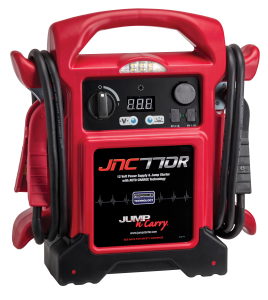
You too can be a jump starting pro if you follow the steps below:
Safety Check List
Always Perform this step before jump starting to ensure safe operation.
- Check to make sure that the clamps and cables are in good working order. Signs that the clamps may be damaged include, but are not limited to the following:
– Burn Marks on the Jaws
– Damaged clamp handles
– Damaged clamp springs
– Damaged cables where copper wiring may be exposed (insulation jacket deteriorated, cut or missing)
- Check to make sure the case is not swollen (a sign of damaged batteries). Verifying these simple check points before every use will keep your jump starter safe to use and increase its service life.
Warning: NEVER charge or jump start a frozen battery.
- Use in a well ventilated area.
- Shield eyes. Always wear protective eyewear when working near batteries.
- Review the jump starter instruction manual and the instruction/safety manual provided by the manufacturer of the vehicle being jump started.
- Turn vehicle ignition off and ensure unit ON/OFF switch (if so equipped) is in the OFF position before making cable connections.
- Clamp the positive (red +) clamp to the positive terminal on the vehicle battery (for negative ground system), or an alternate vehicle starting point as recommended by vehicle manufacturer.
- Clamp the negative (black –) clamp to the vehicle ground (non-moving metal part, such as the vehicle frame).
Note: If the unit sounds a warning upon connection, do not advance to step 7. Determine source of error and resolve it prior to proceeding.
- Turn unit ON/OFF switch to ON position.
- Make sure the cables are not in the path of moving engine parts (belts, fans, etc.).
- Stay clear of batteries while jump starting.
- Start the vehicle (turn on the vehicle ignition).
Note: if the vehicle doesn’t start within 6 seconds, let the jump starter cool for 3 minutes before attempting to start the vehicle again or you may damage the jump starter.
- When the vehicle is started, being careful of moving parts, disconnect the negative (-) battery clamp from the vehicle frame and return it to its holster. Now turn the ON/OFF switch to the OFF position (if the unit features a master ON/OFF switch).
- Disconnect the positive (+) clamp and return it to its holster.
Inevitably, we get comments and questions related to the above sequence. So, we thought we’d try to address those in advance.

Next, we get the question, “What constitutes a good ground?” A good ground almost always means a connection to the vehicle’s frame or engine. What you are looking for is an unpainted bolt connected to the frame or engine. They are usually there, but can take a minute or two to find. We reference an unpainted bolt because you need a good electrical path through the ground connection and a painted surface will inhibit the electrical path.
Lastly, none of this matters if your jump starter is dead on the day you really need it. So, remember to charge it every 90 days. And, we offer free charge alerts, so you don’t even need to remember. Just sign up here and we’ll send you a reminder every quarter so your jump starter is ready when you need it the most.





